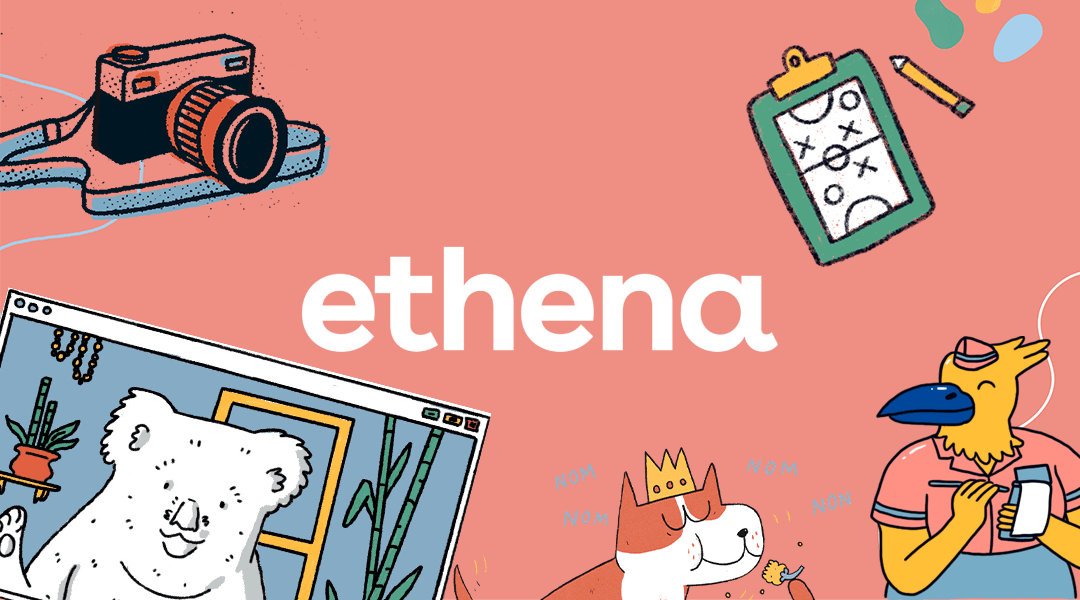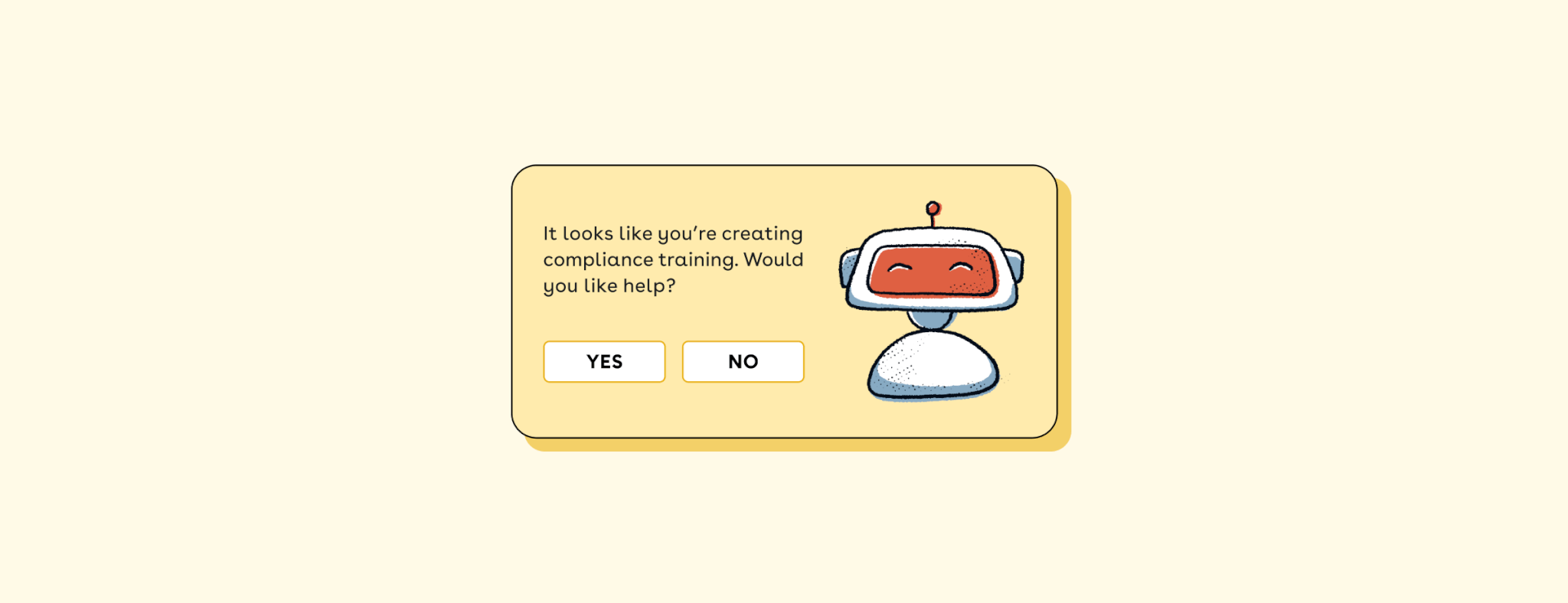Dynamic, multimedia content is what makes our training actually land for learners
“How do you make training content that learners actually like?” Ever since we began making training, we’ve been asking ourselves this question over and over (and so have our customers). Obviously, when it comes to things like required compliance training, not everyone is going to “love” it (still won’t stop us from trying). But, in a world of lazy, “check-the-box,” out-of-date training content, is it so hard to make something that learners can actually, well, learn from?
Our Solution: Dynamic, Multimedia Training Content
Most of us have been through bad training, and it’s usually in one of two forms: text and video. But, as humans with access to the internet, we know that there’s more than one way to pique someone’s interest–especially when the information can be a little dry, but very important!
As a content-focused training company, we’ve translated our training content into many different media and gotten 500,000+ responses about what content misses the mark and what really sticks. One major takeaway? A diversity of multimedia in content matters.
Why does multimedia in training matter?
Using multiple forms of media makes training content stick, for a number of reasons:
- We all have different types of learning styles. Even subject-to-subject, sometimes you just need a visual representation of what you’re reading, or maybe you need to hear someone say it out loud for it to land.
- Switching up the medium makes training less boring! Who wants to read an hour’s worth of text on anti-harassment, anyway? By breaking things up, we introduce a sense of novelty, and every lesson feels that much more fresh and important to absorb. Variety is the spice of life, or so we’ve heard.
- It challenges us to be more creative. Who ever thought they’d be watching a “Cooking the Books” Food Network-style video in their anti-bribery training? And who ever said training content can’t be as creative as the content we’re used to seeing in the real world, anyway? Fun and interesting (and funny) content is what we’re aiming for. The goal is to make it fun for learners, so they engage with and retain more training content.
What types of content does Ethena use in our training?
Let’s take a look at the different types of media we use in our training currently.
Text
Ah, old faithful. From the textbooks we memorized in high school to the news and social media we read every day, text is the baseline for communication.
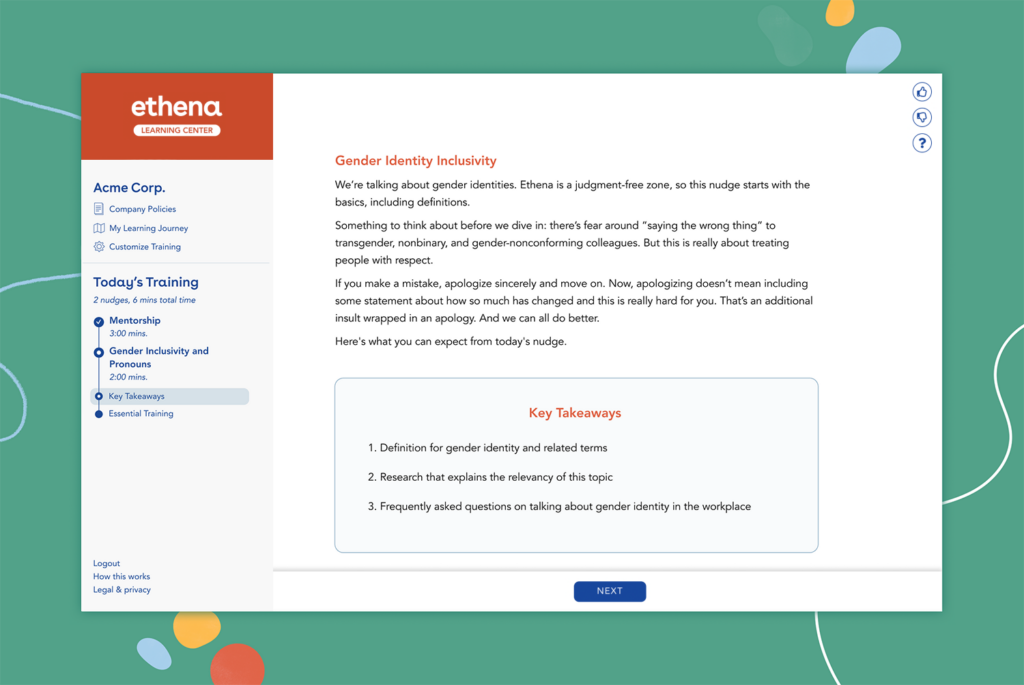
Why text works
- Text is the clearest, most direct way to communicate important information. Training is all about important information, so when it comes to really making sure the lesson lands, we make sure we spell it out.
- It’s a great way to review what you’ve learned so far. Learning isn’t ever accomplished in a straight line; text allows us to circle back to things we may have missed in a video, for example.
- We also use text frequently to link to external resources and additional learning opportunities.
Too much text can be draining (we’ve grown a lot since our text-and-GIFs days!), which is why we keep it short, conversational, and vary it with visual and audio options.
Audio
Did you know that Ethena has an audio track for every course? In the world of streaming audio, why not make training that you can listen to like a podcast?
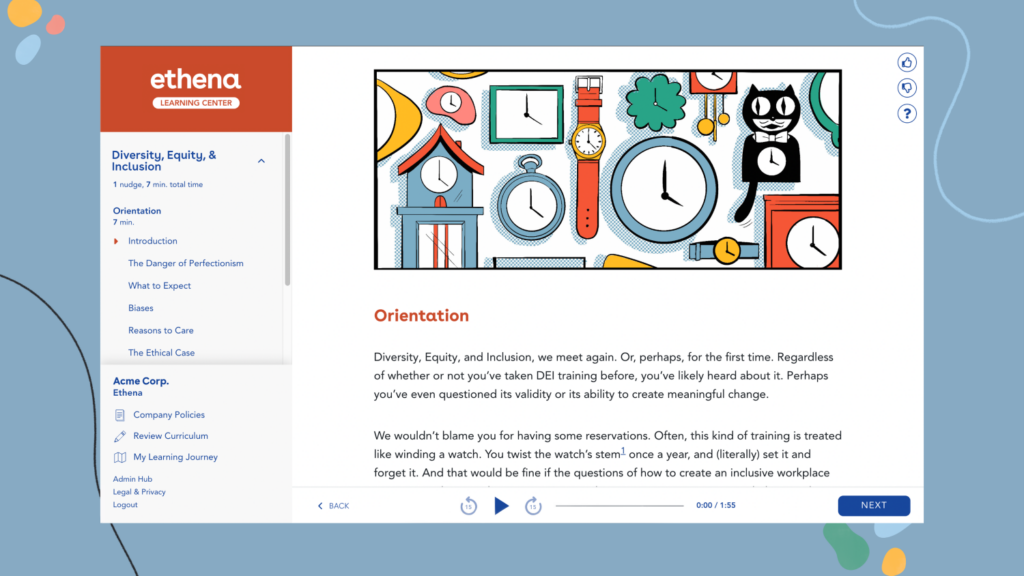
We tried an audio option out last year for the first time (because our customers were asking!) in a lesson on Bullying to overwhelmingly positive feedback. In fact, it was our highest-rated lesson of 2021! We also provide the occasional “radio play” for short-form audio lessons in-between text content. Now, every Ethena training nudge has an audio player at the bottom for folks who prefer to listen to their training rather than read or watch it.
There are two main reasons we’ve made the all-audio upgrade:
- Convenience and screen time: Do your compliance training on a walk, while doing the dishes, or making lunch. Because you can access Ethena’s training from your phone with a single link, you can take our training anywhere–even away from your desk. Get some steps in while learning about bias or inclusive hiring!
- It’s a step forward in accessibility. Accessibility is an ongoing process, and any major step we can take to make training more inclusive for all types of people, we’re happy to do it. An all-audio option is one of those major steps.
Graphic Novels
Most of us are no stranger to illustrations or visualizations in training content. But what does compliance training look like as a comic?
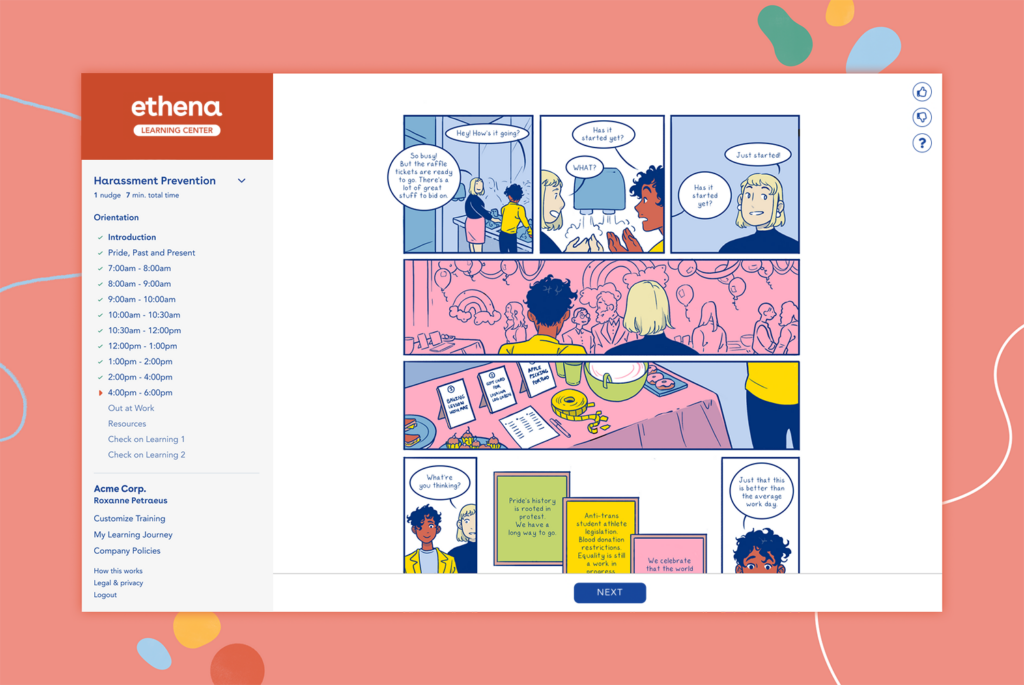
Ever since we started hiring professional illustrators to help us transform entire lessons into full graphic novels, we’ve learned a few things about what makes graphic novels an excellent training medium:
- Comics are great for visualizing complex and nuanced ideas. We can describe things like identity, bias, and intersectionality over and over–there’s a lot to talk about–but supplementing ideas with a visual representation can help these concepts click faster than they would through text or conversation.
- Graphic novels are a subtle way for us to provide representation via illustration. What better way to literally see yourself in your training than by seeing someone tackling the same concepts you’re learning about?
- This might be a little too on the nose, but comics are excellent for visual learners. Sometimes it’s just easier to draw it out!
Short-form Video
“Training videos? Been there, done that, no thank you.” Video training content is one of our favorite subjects to talk about. Who hasn’t watched a bad training video before? And how do you make training videos that remind us less of old Driver’s Ed VHS’s and feel more like a Bill Nye clip? (Here’s looking at you, substitute teachers!)
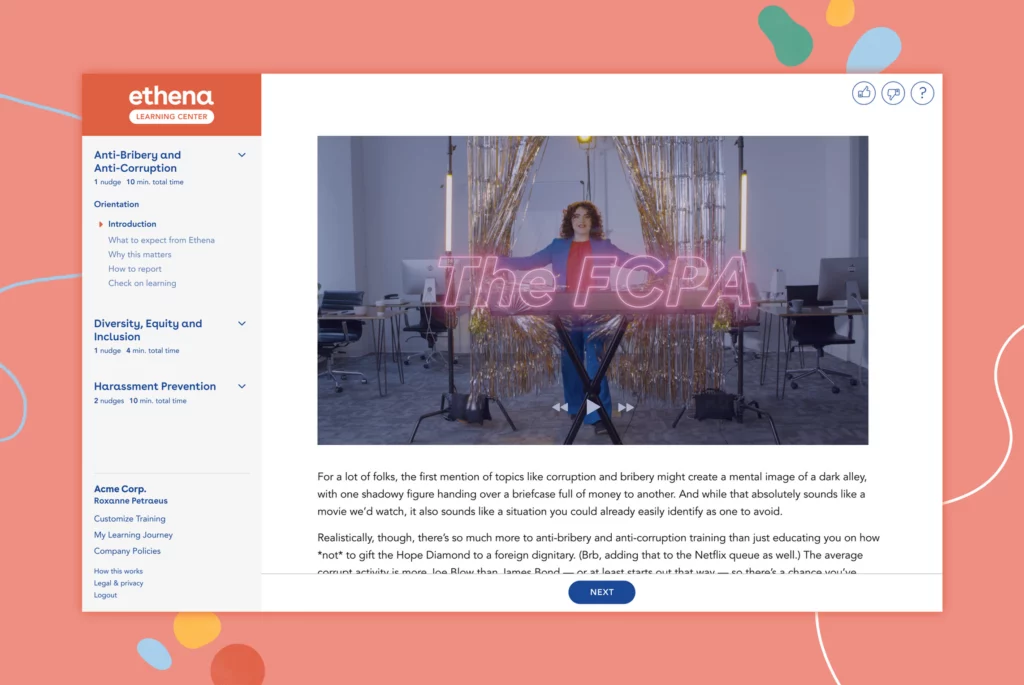
Let’s get the cringe-inducing video conversation out of the way . . .
Why we associate video training with bad training
- Bad quality in video content (even acting) can trump or muddy the message of the video itself. How many bad viral training videos have you seen? We’ve lost count.
- Videos are often reused, repeating the same video year over year, when no one wants to invest real time in training their team. Maybe you’ve seen this on the job or at school, but most of us have a negative association with training videos expressly because bad ones communicate a lack of commitment or care from leadership.
- Lack of relevance–when videos are reused often, they age poorly, becoming more irrelevant as time goes on. We absorb short videos on a daily basis, and training content should reflect that freshness.
Why we use short videos
- Put simply, videos are training at its most dynamic. How else would you get a bribery lesson themed like a 1960s PI Noir film? Or a music video on the FCPA? Sometimes, it’s just easier to watch an example of discrimination–and how to address it–especially in a modern context, like a group Zoom call.
- Our videos feel like clips you’d watch in your feed. We’re not kidding ourselves. It’s 2022. At this point, most learners are YouTube connoisseurs, and so are we. That means our content should be just as stylized, well-produced, and to-the-point as your average professional YouTube channel. Ever wondered how a vlogger would handle the post-pandemic return-to-office experience? We’ve got you covered.
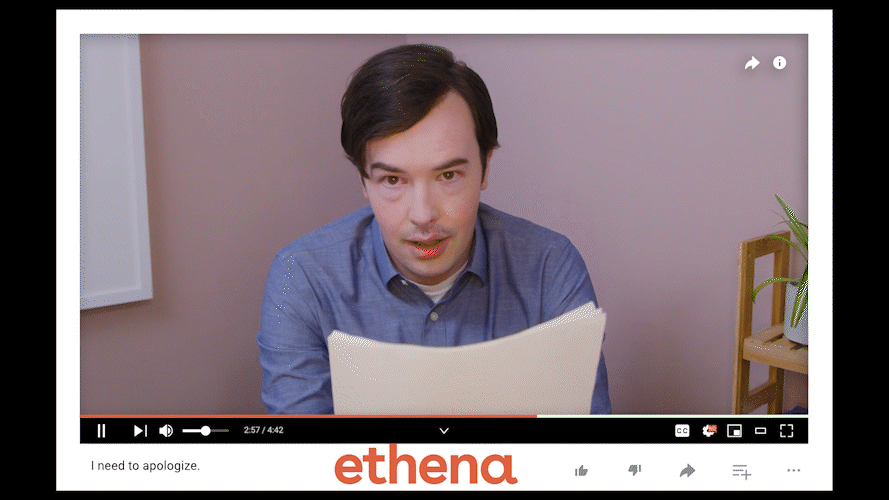
- Videos allow us to bring humor and humanity to some serious subjects that just don’t translate via text. It’s a way for us to be a bit more conversational and real about topics that really matter
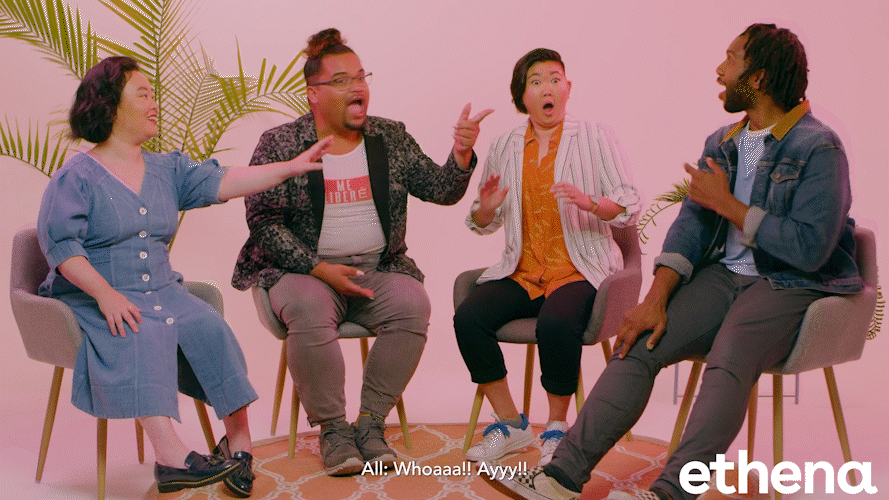
- They’re great ways to model behavior. Learners should leave their training with practical tools for addressing issues in the workplace, including how to talk about sensitive topics at work and be a helpful bystander when you witness harassment and discrimination.
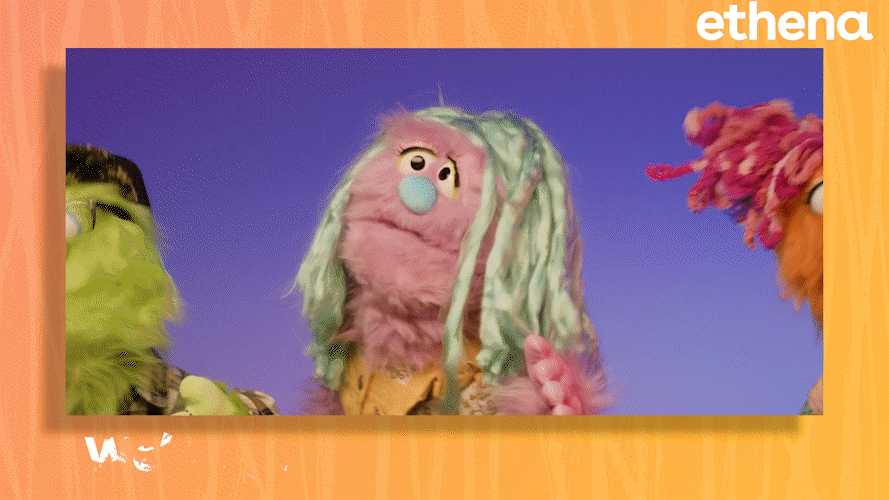
What’s Next?
We’d be lying if we said we didn’t have plenty of dreams and ideas for where our content could go next, especially when it comes to reaching more types of learners out there. We’ll keep experimenting, but our guiding principle will always be the feedback we receive from our learners. That’s all from us for now, and we hope you’re just as excited as we are to see what’s on the horizon. Interested in learning more about Ethena's best-in-class training content? Take a look at our Courses page, or get started and talk to a member of our team.


